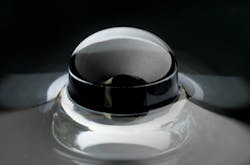Custom aspheric lenses with sub-7-nm surface roughness are 3D-printed
A new photocuring 3D-printing method makes low-cost, high-quality aspheric lenses quickly. Developed by researchers at Northwestern Engineering (Evanston, IL) after two years of research, the resulting custom optical component, which is 5 mm in height and 3 mm in diameter, can be 3D printed in about four hours.1 "Up until now, we relied heavily on the time-consuming and costly process of polishing lenses," says Cheng Sun, an associate professor of mechanical engineering whose lab developed the 3D printing process. "With 3D printing, now you have the freedom to design and customize a lens quickly."
RELATED: 3D printing without layers takes minutes, not hours
RELATED: Nanoscribe's optical 3D printers fabricate myriad types of micro-optics
The 3D-printed asphere was mounted to an Apple iPhone 6s and images were taken that included high-quality detailed photos of a sunset moth's wing and a spot on a weevil's elytra (wing cases).
Like many types of 3D printing, creating these lenses involves placing layer upon layer of material. But when researchers first printed the lens, its curved layers, made of a photocurable resin, created a visible stepping.
"We realized that the layers on top of each other created surface roughness," says Sun. "The layer thickness is typically 5 µm, while the wavelength of visible light is around 0.5 µm. This creates an optically rough surface. That was the bottleneck. The roughness made the lens incapable of clear optics."
Two-step process
To solve the challenge of making the surface smooth without slowing down the printing speed, Sun’s group developed a two-step process of layering and polishing. "First, we used grayscale images to create more transitions between steps," Sun says. "Then, we coated the surface with the same photo-curable resin. That then forms the meniscus that further smooths the surface."
The result: a transparent lens with a smooth surface.
"I must have tried more than 100 times to get this just right," says Xiangfan Chen, a PhD candidate in mechanical engineering and lead author on the study.
This lens, however, is not the first high-quality lens created by 3D printing, however. German-based company Nanoscribe has developed a high-precision femtosecond 3D printer with 150 nm precision, but it builds the lens in a point-by-point fashion instead of layering, Sun says. "It is a time-consuming process. That is their limitation," he notes. "We wanted to make something comparable but faster and with better quality."
The lenses can be printed at a volume rate of 24.54 mm3/h.
The group will next try to make larger lenses as well as investigate how to integrate the 3D-printed lens with medical devices, such as an endoscopes or optical microscopes.
The lenses could be used by doctors in underdeveloped areas for diagnostic imaging or by field scientists as portable microscopes. The lens could also be fashioned into a customized contact lens for people with distorted corneas caused by keratoconus.
Source: http://www.mccormick.northwestern.edu/news/articles/2018/03/new-method-speeds-up-3d-printing-of-millimeter-sized-imaging-lenses.html
REFERENCE:
1. Xiangfan Chen et al., Advanced Materials (2018); https://doi.org/10.1002/adma.201705683
About the Author
John Wallace
Senior Technical Editor (1998-2022)
John Wallace was with Laser Focus World for nearly 25 years, retiring in late June 2022. He obtained a bachelor's degree in mechanical engineering and physics at Rutgers University and a master's in optical engineering at the University of Rochester. Before becoming an editor, John worked as an engineer at RCA, Exxon, Eastman Kodak, and GCA Corporation.

